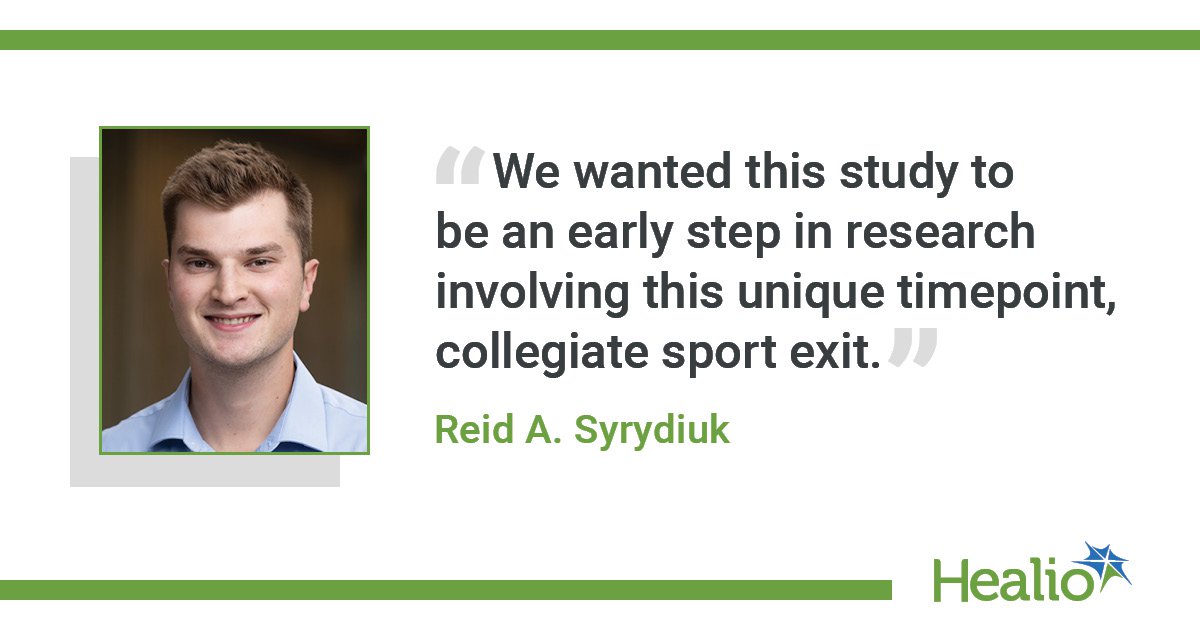October 10, 2025
3 min read
Key takeaways:
- The study examined 3,663 NCAA athletes who answered a battery of self-reported health questionnaires.
- The researchers acknowledged that more longitudinal study is necessary in this patient population.
College student-athletes who reported three or more concussions during their athletic careers had worse mental and neurobehavioral health outcomes compared with those who had no concussion history at collegiate career end, data show.
Although prior research has established the immediate and long-term effects of concussion and repetitive head impact (RHI) in collegiate student-athletes, there is little record of how these types of injuries impact this population in the short term, once their athletic careers have concluded, Reid A. Syrydiuk, MSc a doctoral student at the University of Michigan Concussion Center, and colleagues wrote in Brain Injury.

“Existing studies usually examine the acute (minutes, hours, days after injury) or long-term (decades into retirement) effects of concussion and contact sports, leaving a gap in that intermediate timepoint between active career and years into retirement,” Syrydiuk told Healio.
As a result, Syrydiuk and colleagues sought to examine how history of concussions, exposure to bodily contact and years of primary sport participation (YoP) affect student-athletes’ health through questionnaires distributed during their senior season, hypothesizing that greater exposure and length of play would have negative effects.
“We wanted this study to be an early step in research involving this unique timepoint, being collegiate sport exit,” Syrydiuk said. “This post-competitive period not only represents the end of a career, but a massive shift in an athlete’s life, and retirement can lead to major shifts in daily routine, identity and support systems.” Further, he noted, researchers aimed to ensure that student-athletes are recognized and supported as individuals both during and after their collegiate athletic careers concluded.
Their research included 3,663 collegiate student-athletes (mean age 21.6 years; 51.5% women) enrolled in the Concussion Assessment, Research and Education (CARE) Consortium prospective cohort study, which features 26 civilian universities and four military service academies in the United States.
“The size and diversity of participants in CARE Consortium is a robust strength that is highlighted by this study,” Syrydiuk said.
All participants were initially stratified by concussion history, with 64.6% reporting no concussion history, 30.4% reporting one or two concussions and 5.1% reporting three or more.
With a mean sport participation time of 13 ± 3.8 years, YoP categories included 4 or fewer years (1.1%), 5 to 8 years (11.2%), 9 to 14 years (44.4%) and more than 14 years (43.3%).
Athletes participated in high exposure sports such as football or ice hockey (n = 1,549; 42.3%), low exposure sports such as basketball (n = 1,112; 30.4%) or unexposed sports such as golf (n = 1,002; 27.4%). Also, 69.5% of the student-athletes participated in NCAA Division I sports.
“This wide net allowed us to compare outcomes across different contact levels and uncover patterns that a narrower focus on contact sports alone wouldn’t reveal,” Syrydiuk said. Participants completed eight self-reported assessments spanning a range of physical, neurobehavioral, mental and cognitive health: Quality of Life in Neurological Disorders (Neuro-QoL); Alcohol Use Disorders Identification Test (AUDIT); Pittsburgh Sleep Quality Index (PSQI); Satisfaction with Life Scale (SWLS); Patient Health Questionnaire-9 (PHQ-9); Short Form Survey-12 Mental Component Summary (SF-12 MCS); Short Form Survey-12 Physical Component Summary (SF-12 PCS); and Neurobehavioral Symptom Inventory (NSI) within their departure year.
Statistical analysis attempted to clarify associations between sport contact exposure, number of concussions and YoP on questionnaire scores while adjusting for covariates such as sex, race and self-reported athlete-identity and resiliency scores.
According to results, those with three or more concussions logged more adverse scores vs. those without concussion history on the PHQ-9 (depressive symptoms). Both low- and high-contact exposure athletes had significantly better scores on the PHQ-9 than unexposed athletes, with increased YoP also a beneficial factor with this metric. Increased YoP was also associated with higher (i.e., beneficial) SF-12 MCS scores.
For cognition, those who engaged in low-exposure sports reported higher, and therefore more beneficial, scores compared with unexposed participants on the Neuro-QoL, but neither concussion history nor YoP were associated with these scores.
Syrydiuk and colleagues reported that individuals with one or two concussions fared poorer on the SF-12 PCS and PSQI vs. those without concussion history, but they noted that neither sport exposure level nor YoP were factors in any physical or behavioral metric score.
In addition, those with three or more concussions logged higher NSI scores compared with their counterparts without concussions. However, both low- and high- contact exposed athletes reported lower NSI scores than unexposed athletes.
“Our findings highlight that those with multiple concussions may report some worsened health outcomes (even as approach career end) than those with none,” Syrydiuk said. “Additionally, our results suggest that consideration of athlete brain health and wellbeing should extend beyond just contact sports, as some non-contact athletes reported worse mental health than contact athletes.”
For more information:
Reid A. Syrydiuk, MSc, can be reached at syrydiuk@umich.edu or on LinkedIn here.









